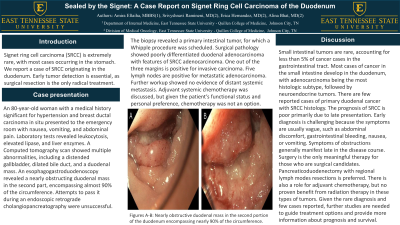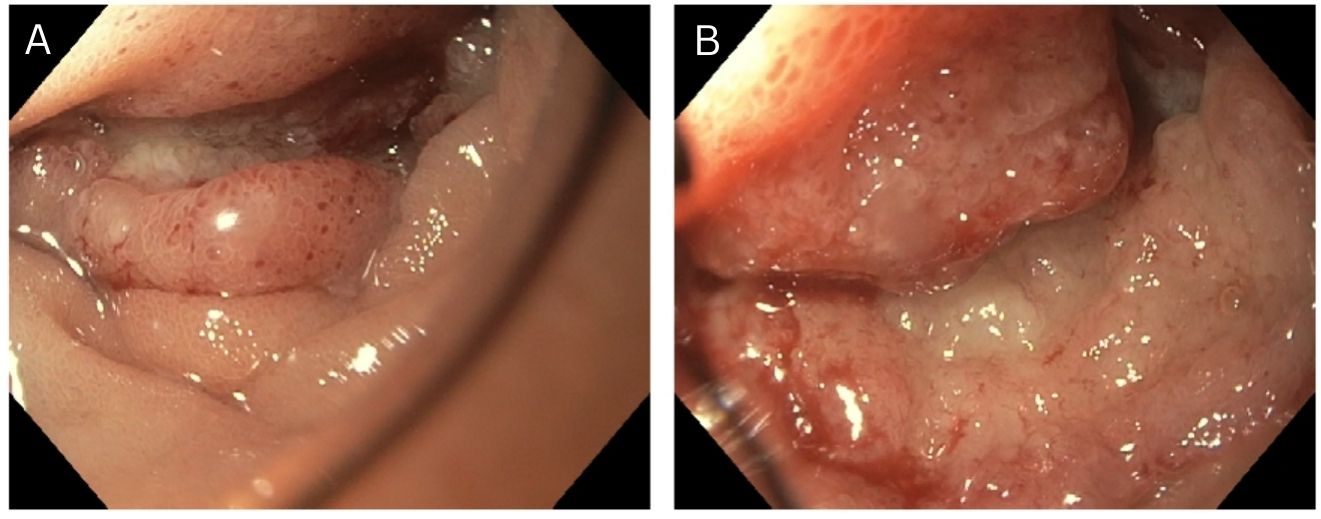Monday Poster Session
Category: Small Intestine
P3274 - Sealed by the Signet: A Case Report on Signet Ring Cell Carcinoma of the Duodenum
Monday, October 28, 2024
10:30 AM - 4:00 PM ET
Location: Exhibit Hall E

Has Audio
- AE
Amira Eftaiha, MBBS
East Tennessee State University
Johnson City, TN
Presenting Author(s)
Amira Eftaiha, MBBS, Srivyshnavi Ramineni, MD, Erica Roman, MD, Alina Bhat, MD
East Tennessee State University, Johnson City, TN
Introduction: Signet ring cell carcinoma (SRCC) is extremely rare, with most cases occurring in the stomach. We report a case of SRCC originating in the duodenum. Early tumor detection is essential, as surgical resection is the only radical treatment.
Case Description/Methods: An 80-year-old woman with a medical history significant for hypertension and breast ductal carcinoma in situ presented to the emergency room with nausea, vomiting, and abdominal pain. Laboratory tests revealed leukocytosis, elevated lipase, and liver enzymes. A Computed tomography scan showed multiple abnormalities, including a distended gallbladder, dilated bile duct, and a duodenal mass. An esophagogastroduodenoscopy revealed a nearly obstructing duodenal mass in the second part, encompassing almost 90% of the circumference. Attempts to pass it during an endoscopic retrograde cholangiopancreatography were unsuccessful. The biopsy revealed a primary intestinal tumor, for which a Whipple procedure was scheduled. Surgical pathology showed poorly differentiated duodenal adenocarcinoma with features of SRCC adenocarcinoma. One out of the three margins is positive for invasive carcinoma. Five lymph nodes are positive for metastatic adenocarcinoma.
Further workup showed no evidence of distant systemic metastasis. Adjuvant systemic chemotherapy was discussed, but given the patient’s functional status and personal preference, chemotherapy was not an option.
Discussion: Small intestinal tumors are rare, accounting for less than 5% of cancer cases in the gastrointestinal tract. Most cases of cancer in the small intestine develop in the duodenum, with adenocarcinoma being the most histologic subtype, followed by neuroendocrine tumors. There are few reported cases of primary duodenal cancer with SRCC histology. The prognosis of SRCC is poor primarily due to late presentation. Early diagnosis is challenging because the symptoms are usually vague, such as abdominal discomfort, gastrointestinal bleeding, nausea, or vomiting. Symptoms of obstructions generally manifest late in the disease course. Surgery is the only meaningful therapy for those who are surgical candidates. Pancreaticoduodenectomy with regional lymph modes resections is preferred. There is also a role for adjuvant chemotherapy, but no proven benefit from radiation therapy in these types of tumors. Given the rare diagnosis and few cases reported, further studies are needed to guide treatment options and provide more information about prognosis and survival.

Disclosures:
Amira Eftaiha, MBBS, Srivyshnavi Ramineni, MD, Erica Roman, MD, Alina Bhat, MD. P3274 - Sealed by the Signet: A Case Report on Signet Ring Cell Carcinoma of the Duodenum, ACG 2024 Annual Scientific Meeting Abstracts. Philadelphia, PA: American College of Gastroenterology.
East Tennessee State University, Johnson City, TN
Introduction: Signet ring cell carcinoma (SRCC) is extremely rare, with most cases occurring in the stomach. We report a case of SRCC originating in the duodenum. Early tumor detection is essential, as surgical resection is the only radical treatment.
Case Description/Methods: An 80-year-old woman with a medical history significant for hypertension and breast ductal carcinoma in situ presented to the emergency room with nausea, vomiting, and abdominal pain. Laboratory tests revealed leukocytosis, elevated lipase, and liver enzymes. A Computed tomography scan showed multiple abnormalities, including a distended gallbladder, dilated bile duct, and a duodenal mass. An esophagogastroduodenoscopy revealed a nearly obstructing duodenal mass in the second part, encompassing almost 90% of the circumference. Attempts to pass it during an endoscopic retrograde cholangiopancreatography were unsuccessful. The biopsy revealed a primary intestinal tumor, for which a Whipple procedure was scheduled. Surgical pathology showed poorly differentiated duodenal adenocarcinoma with features of SRCC adenocarcinoma. One out of the three margins is positive for invasive carcinoma. Five lymph nodes are positive for metastatic adenocarcinoma.
Further workup showed no evidence of distant systemic metastasis. Adjuvant systemic chemotherapy was discussed, but given the patient’s functional status and personal preference, chemotherapy was not an option.
Discussion: Small intestinal tumors are rare, accounting for less than 5% of cancer cases in the gastrointestinal tract. Most cases of cancer in the small intestine develop in the duodenum, with adenocarcinoma being the most histologic subtype, followed by neuroendocrine tumors. There are few reported cases of primary duodenal cancer with SRCC histology. The prognosis of SRCC is poor primarily due to late presentation. Early diagnosis is challenging because the symptoms are usually vague, such as abdominal discomfort, gastrointestinal bleeding, nausea, or vomiting. Symptoms of obstructions generally manifest late in the disease course. Surgery is the only meaningful therapy for those who are surgical candidates. Pancreaticoduodenectomy with regional lymph modes resections is preferred. There is also a role for adjuvant chemotherapy, but no proven benefit from radiation therapy in these types of tumors. Given the rare diagnosis and few cases reported, further studies are needed to guide treatment options and provide more information about prognosis and survival.

Figure: Figures A-B: Nearly obstructive duodenal mass in the second portion of the duodenum encompassing nearly 90% of the circumference.
Disclosures:
Amira Eftaiha indicated no relevant financial relationships.
Srivyshnavi Ramineni indicated no relevant financial relationships.
Erica Roman indicated no relevant financial relationships.
Alina Bhat indicated no relevant financial relationships.
Amira Eftaiha, MBBS, Srivyshnavi Ramineni, MD, Erica Roman, MD, Alina Bhat, MD. P3274 - Sealed by the Signet: A Case Report on Signet Ring Cell Carcinoma of the Duodenum, ACG 2024 Annual Scientific Meeting Abstracts. Philadelphia, PA: American College of Gastroenterology.

